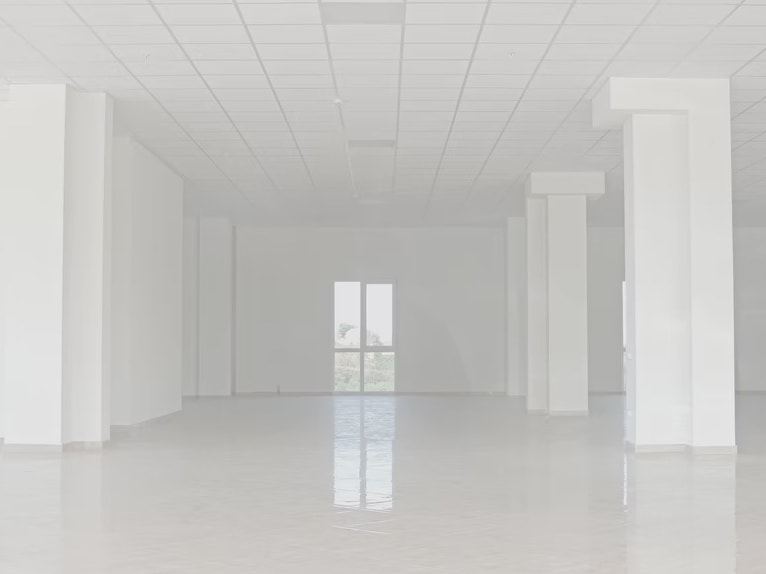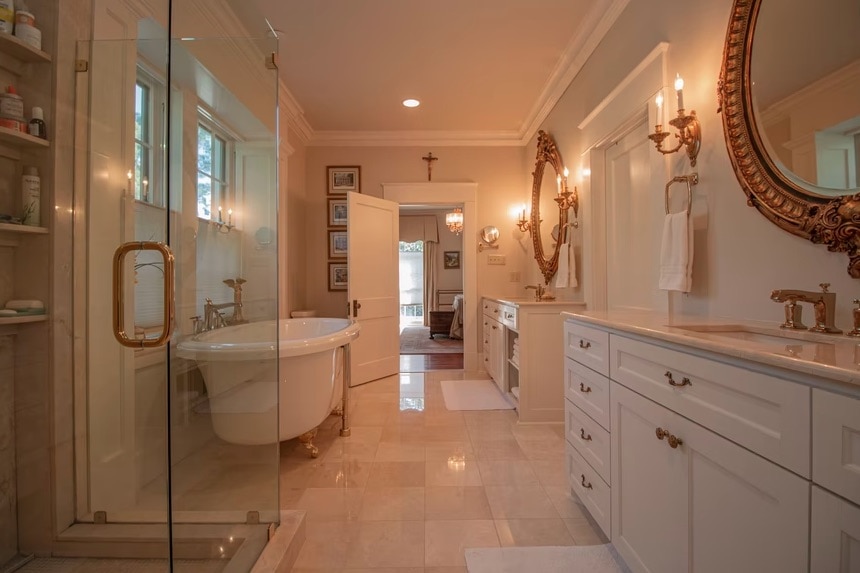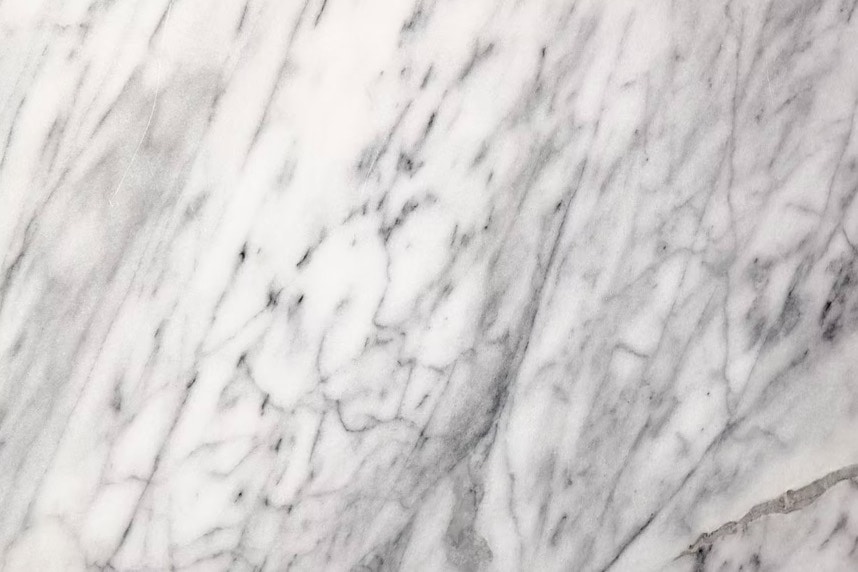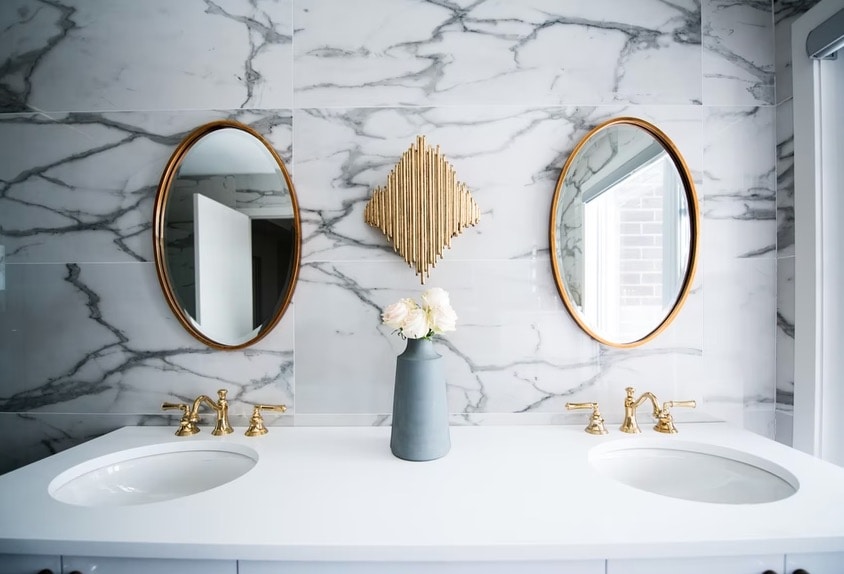When choosing a new tile for your floor, there are lots of products on the market. Beyond appearance, there are other important features to think about like durability, ongoing maintenance, and regular cleaning. Marble and porcelain tile are two popular materials, and both can be used in your next flooring project.
Marble, quarried in mountainous regions worldwide, has been a very popular building material for millennia. Prized for its beauty, style, and elegance, this material has graced the palaces of kings and queens for centuries, making it an upscale, luxurious option for interiors. But as a flooring material, it requires more maintenance and is more susceptible to damage than ceramic tile and other forms of natural stone.
Beautiful marble flooring started its journey into our homes as limestone. Millions of years of metamorphosis—intense heat and pressure—produced a dense variegated stone that can be polished to a high shine. Marble is now mined worldwide and is highly prized as a natural product for countertops and flooring. Polished marble reflects light to make rooms seem more spacious while offering a touch of elegance.
Marble has been used to create elegant floors for thousands of years, and its sophisticated good looks continue to make it popular today. With its striking grain patterns and creamy colours, it’s one of the most recognizable — and beautiful — natural building materials.
Yet for such an upscale material, marble is also durable and easy-care. As a result, you’ll find it often installed in “wet” environments, such as kitchens and bathrooms, where frequent water splashes can be simply wiped away without causing damage. So if you’re thinking about incorporating this fabulous flooring into your home design, read on to learn what types of marble are available, how to choose the best one for your budget, and glean some DIY tips should you opt to tackle installation yourself.
Marble, like most stone tiles, has high maintenance requirements. It must be sealed and cleaned regularly; for cleaning, use only a mild detergent solution or a product specially designed for marble. Never set your drink down on a marble surface (it will leave a ring), and wipe up any spills immediately as they can stain or etch the marble’s porous surface.
Marble has been a popular building material since before the Ancient Grecian times, as that is when marble was first used in construction. Still, in 2020, marble is prized for its elegance and classic style. While it may have been the material of choice for kings and queens, it now can be incorporated into any household. It can be used as countertops, wall tiles, and flooring. Marble flooring offers an instant elevation of appearance. If you are considering installing marble floors, here is what you need to know.
The Geology of Marble

Marble is a very popular natural stone that is quarried and cut into slabs and tiles for various residential and commercial building applications, including countertops, floors, and wall tiles. It is a metamorphic rock that forms when a sedimentary stone, such as limestone, is transformed under heat and pressure into a harder stone with beautiful colour and veined patterns. Marble is sometimes confused with granite. However, granite is an igneous rock derived from volcanic magma, not layered sedimentary rock. Granite typically has a pebbly or spotted colour pattern, while marble usually has a wavy veined pattern.
Frequently Asked Questions About Marble Floors
Which marble is better for home?
Italian marble is soft but available at a thickness of 18 to 20 mm, making it conducive to small hairline cracks over time. On the other hand, Indian marble is much more durable.
Why is marble not good for kitchens?
In the kitchen, that means marble countertops can scratch and scuff more easily than other surfaces, such as granite or quartz. Marble is also a porous stone, so it’s more prone to staining due to harsh cleaning products or acidic liquids.
Is marble floors more expensive than wood?
The price per foot is more comparable to wood, but marble still has a longer life span. When you add in the lower repair and maintenance costs, it becomes apparent that marble is the more cost-effective choice for all types of property owners.
Installation
Any tiling project requires an assessment of the existing subfloor one and may require replacement or upgrading. In addition, in any floor installation project, subfloor 1 must be clean, level, and sturdy enough to support the weight of the tile.
Marble tiles can be fragile and difficult to match and, therefore, should be laid out on your floor before installation to make sure you are happy with the overall design. In addition, experts suggest mixing tiles from different boxes to achieve a more balanced look.
Marble tile is installed in much the same way as ceramic or any other natural stone tile. A layer of cement board (backer board) is first laid over the subfloor, and then the tiles are glued down with a thin-set adhesive. After the adhesive dries, the joints between the tiles are filled with cementitious grout. But unlike most ceramic tile, which requires only that the grout lines be sealed, marble requires that the entire surface be sealed immediately after installation, then every year or so after that.
Although the techniques are similar to those for installing ceramic tile, DIY installation can be a tricky affair. Marble tile is a very heavy but brittle stone, and unprepared DIYers may find that they waste a good deal of material through breakage. In addition, proper preparation of the subfloor is critical, and as a natural stone, marble is considerably more difficult to cut and drill, requiring specialty tools. For these reasons, most people choose to have pros install marble floor tiles.
Marble tile is more difficult to install than porcelain tile, so that a DIY installation can be tricky. Some marble is brittle or may require an epoxy mortar to install, so if you aren’t familiar with installing it, you may want to consult a professional. Also, proper prep for the subfloor is crucial. Unfortunately, many people choose to leave it to the pros for these reasons.
Marble is a great conductor of heat, making it easily adaptable to various below-surface radiant heating systems. Radiant heating can eliminate one of the prime disadvantages of marble tile—its coldness underfoot. A marble floor heated from beneath with radiant coils can bring a rush of cozy warmth that is both unexpected and delightful, especially on cold winter mornings.
Porcelain tiles are heavy and require a special mortar 2, grout 3, and tools, which are different from those used for other ceramic tiles. This can make the installation process very time consuming and increase the cost.
Costs
Porcelain tiles cost on average between $3 and $5 per square foot for materials and between $5 and $10 per square foot for installation. Tiles cannot be installed directly onto a wooden subfloor one and may need cement backer boards installed at the cost of $4 to $7 per square foot. Expect average total costs to be between $8 and $15 dollars per square foot installed.
The cost of marble tiles varies depending on the type, but generally, they are more expensive than porcelain tiles. But the benefit is that you have a unique and beautiful project that will be much less trendy than many ceramic tiles. Marble has a timeless quality to it.
Marble floors are a premium architectural element, and they are priced accordingly. Generally, they fall on the high-end range of all-natural stone, and they generally do not last as long as slate, granite, and other natural stone. Marble floors typically cost $10 to $20 per square foot1 for materials alone, with some specialty marbles running as high as $40 per square foot. Ceramic tile is typically about half the cost of marble, although installation labour is fairly comparable. Professional installation labour adds $3 to $7 per square foot. The installation will cost more for jobs requiring complicated layouts or lots of cutting; the labour cost is lower if the layout involves a simple layout of square or rectangular tiles.
Marble tile is typically more expensive and costs on average between $5 and $15 per square foot for materials, and installation averages between $4 and $9 per square foot. These tiles are prone to breaking, so plan to buy between 10%–20% more than needed. Expect average total costs to be between $9 and $24 dollars per square foot installed.
Regardless of the tile choice, the shape of the floor, pattern or complexity of the design, and the size of the tiles will determine installation cost. Projects that require more detailed work or cutting of the tile will be more expensive. If the installation requires detailed work, expect costs to be 15% – 20% more.
Common Types For Marble Floors Include:
Breccia marble features striking grain and swirl patterns that often look like bubbles trapped in rock. In addition, breccia tends to darker, warm shades of tan, red and gold.
Carrara is the classic marble associated with Roman and Greek temples and statues. It’s a warm white marble streaked with subtle bands of grey. In addition to marble flooring, Carrara often is used for architectural details, such as fireplace surrounds.
Calacatta marble often is confused with Carrara. They’re similar, but classic Calcutta typically is a more pure white colour with bolder streaks. Calacatta is the rarer of the two and prized for its upscale appearance. Consequently, it’s more expensive.
Marble flooring comes in tiles of various shapes, from large rectangles to smaller mosaics. Prices range from $5 to $50 per square foot. Like many types of natural stone, marble floors can be tricky to install and a challenging DIY project. Skilled professional installers can cut marble into various shapes to create curves and patterns, but you’ll pay installation charges of $15 to $50 per square foot for the privilege.
Maintenance and Repair

Once installed, routine maintenance of a marble tile floor is relatively easy; it requires the same kind of sweeping and damp mopping you would do with a ceramic tile floor. However, marble is fairly porous, unlike ceramic tile, so you shouldn’t allow water to puddle and stand on the surface. In addition, standing water can penetrate the stone and discolour it.
Marble is softer than porcelain tile and can be scratched or chipped. But, marble can be resurfaced and repolished (similar to wood flooring) and be made to look new again. In addition, since marble is a natural stone, it goes all the way through so that the face can be repaired repeatedly. Deep stains, however, may require more finesse to clean and eradicate. But, if you keep it sealed, it will be easier to maintain overall.
As marble is a natural stone product, it is porous, meaning it has tiny holes, requiring a surface sealant to prevent permanent stains. After the initial installation and sealing, it’s recommended that you reseal your marble tile every six to twelve months depending on how much foot traffic it gets. Mild acids found in the kitchen – like vinegar or lemon juice – can cause problems to the finish. Depending on the type of stain, specialized cleaning products may be necessary. Marble tile is also susceptible to chips, cracks, and breakage and can be scratched by vacuuming.
Porcelain tile is manufactured from clay and fired in a kiln, making it very hard and durable. It is moisture- and stain-resistant, and easy to clean. While the tiles are durable, the mortar two and grout 3 used for installation are more vulnerable to moisture and require a surface sealant to prevent water absorption. If grout 3 or mortar 2 does get wet, it can compromise the flooring or lead to mould growth.
Marble has a pH on the base (alkaline) side due to its origin as a sedimentary limestone. This means that it can have a chemical reaction whenever it comes in contact with acidic substances. This can include a wide variety of foods, sauces, beverages, and cleaning products. Unfortunately, the discolouration stains that come from these materials are usually permanent. This can be prevented by applying a penetrating chemical sealer and a surface sealer after installation. But for optimal protection, the surface sealer needs to be reapplied annually.
Even though it is stone, marble is actually a relatively soft material that can be scratched, scraped, and chipped under the wrong conditions. This is especially true if the material is polished, as the imperfections will be more noticeable in the smooth, flat solid surface. Unfortunately, scratches cannot be easily repaired without replacing the damaged material entirely.
Design
The biggest advantage of marble floor tile is that it instantly elevates the appearance of a space, giving it a regal bearing that is hard to imitate. And marble is available in multiple colours and even in stunning multicolour mixes, providing flexible options for various decorative schemes. Tiles can also be cut to rectangles and triangles of varying sizes to create complex mosaic installations.
Because it is a product of the earth, every piece of marble tile used in every single floor is one-of-a-kind; there is no other like it anywhere in the world. This uniqueness can be quite pronounced in the case of multi-coloured marble, with distinct features blaring forth from every tile. With more solid-coloured marble, the colour differences shifts are much more subtle and subdued, but your floor will still stand out with its own personality.
Unlike most natural stones, marble can take a very high polish, achieving a silky smooth and shimmering look when treated properly. This look of sophistication and glamour evokes the highest sense of elegance in a space.
Marble Flooring Pros
Unique Style
If there is one thing that marble flooring has above all others, it is elegance. It immediately makes a room seem more upscale. There just is nothing that can duplicate real stone because you can never have a repeat. No two marble tiles are exactly the same. You will have a unique job to you because of the very nature of the actual stone.
Polish / Light
Polished marble is very smooth and shiny and is an extremely attractive look. It reflects light and can give the illusion that it is translucent. A polished finish also brings out the colours in marble. The darker marbles like Nero Marquina or bardiglio allow light to glimmer on its surface and look dramatically elegant. Light-coloured marble-like Carrara or Calcutta is clean and classic and will be aesthetically relevant for years to come. Bear in mind that marble may also be available in honed if you do not want the polished look.
Natural Material
Marble is quarried around the world in mountainous regions. It is a natural metamorphic rock formed under heat and pressure. This gives marble its usually wavy and veined patterns. Marble is 100% natural and earth made. If you prefer natural over synthetic materials, this is the way to go.
Maintenance
Routine maintenance is pretty simple. First, sweep and use a damp mop, similar to ceramic tile flooring. However, be careful to use cleaners that are safe for marbles. Use a cleanser that is not too acidic, not too alkaline. We find Mr Clean usually does the trick or experiment with your favourite organic cleaner. Next, you will need to reseal your stone periodically. This is not difficult to do. If water does not lay on the surface of the stone like a newly waxed car, it’s time to reseal. The extra care is worth the spectacular beauty that you will have in your home.
Radiant Heat
If you are looking for radiant heat on your floors, marble is a great choice. Because marble is a great conductor of heat, it is ideal for radiant heating systems, which is the best way to combat having a cold floor. Schluter Ditra Heat will also offer an uncoupling substrate to help protect your marble in the years to come.
Marble flooring tiles come in two basic finishes:
Polished marble is finished to a high sheen that shows off the beauty and grain of the stone. However, the finish can be slick and slippery, especially when wet. One strategy is to make liberal use of area rugs to protect from slipping. In addition, a lot of maintenance is required to keep polished marble floors looking good.
Honed marble is polished but to a much lesser degree. So while the flooring won’t be as stunning, it’s a much more sensible finish, especially in high traffic areas or wet rooms, such as kitchens and baths, where the slightly rougher surface texture provides better traction.
Because it’s a natural stone, marble has a porous surface. To help keep it looking beautiful, marble flooring should be refinished every six to 12 months with a quality stone sealer made for marble. Unfortunately, it’s also one of the softer stones — high heels and dog claws are not marble’s best friends.
Unfortunately, marble also has a well-deserved reputation for staining. Orange juice, harsh cleaners and any acidic substances should be cleaned up immediately. Some homeowners report that even water causes staining. The best way to live with marble flooring is to assume that, over time, the floors will develop a unique patina.

Best Use
Marble tiles are not recommended for humid or wet areas like kitchens, bathrooms, or basements because marble will absorb moisture, leading to warping, dulling, and deterioration over time. In addition, due to its polished finish, marble can be very slippery when wet.
Porcelain tile is extremely durable, making it an excellent choice for areas with lots of traffic. However, Grout 3 used in porcelain tile installations in bathrooms, kitchens, and other damp or humid areas will need to be sealed to prevent damage and mould growth because grout three can absorb moisture.
